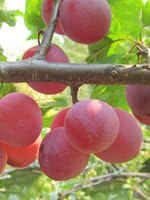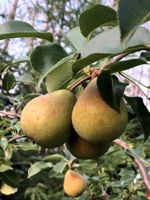Mon-Fri 9am - 5pm Mountain time
Pembina Plum vs Beedle Pear
Prunus nigra x salicina Pembina
Pyrus Beedle
SOLD OUT
Pembina Plum is one of the best-tasting plums that can be planted on the prairies. It is semi-freestone with orange flesh that is soft, juicy, and sweet which contrasts with the thick, sour, dark red skin. The plums can grow up to 5 cm in diameter and are well-suited for fresh eating, baking, and preserves.
They typically ripen in mid to late August and should be picked as soon as they are ripe. If left too long, the fruit will fall off the tree.
Pembina Plum is a hybrid between Canada Plum and Japanese Plum. For fruit production, it needs to be planted with another variety for cross-pollination. Canada Plum and American Plum are considered universal pollinizers.
Beedle Pear is sweet, soft, and juicy with no astringency making it great for fresh eating. They typically ripen on the tree in early September. The medium-sized pears keep relatively well when compared to other varieties. For most years it is a reliable producer on the prairies.
The Beedle Pear is a cold hardy pear with Canadian roots. John Beedle discovered it on a city boulevard in St. Albert, Alberta.
For fruit production, another pear variety is required for cross-pollination. Can be paired with Krazulya Pear or Ussurian Pear.

